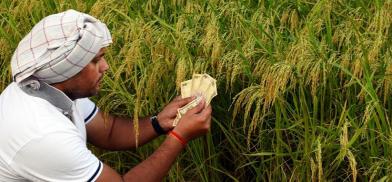Strengthening of rural institutions a must to revive economy
The economic discourse in India in a little over two months has changed from one of confidently steering the economy through investment and consumption measures to one of the stimulus packages for the needy and the vulnerable by government and liquidity infusion by RBI for businesses and jobs to survive, writes Partha Pratim Mitra for South Asia Monitor

The COVID-19 pandemic, it is widely apprehended, will be driving the world economy to retreat from global economic integration, especially for medical gear and food, and an emphasis on domestic sourcing. In response to the current health and economic crisis, policymakers globally appear poised to take deliberate steps to reinforce the movement toward delocalization. Even before the COVID-19 crisis, the growth of global supply chains had been stalled, in part because China had relied less on exports and had turned inward toward indigenous development of leading industries.
At a more popular level, the present situation has been described as a planet, which is today not only just interconnected, but in many ways even fused together. Although this global interconnection has triggered economic growth, it has also meant that when things become adverse in one place, it can be transmitted to other regions quicker than ever. The corona pandemic is one such adverse outcome of global interconnectivity. The economic culmination in the US of the pandemic has put several businesses and employers, who had invested in long-term assets that they were assuming would go up in value with borrowed money, find themselves unable to repay to banks and financial institutions.
The Federal Reserve in the US, therefore, needs to intervene to protect banks and help them to restructure their debts and get fresh cash into the hands of all their workers so they can meet their consumption needs after their last paycheck are spent.
The present economic situation in India is somewhat akin to that of the US but the levels of vulnerability of the workers from the informal sector including migrant labour, which constitutes the vast majority of the workforce in India is much higher.
What was the official economic discourse in India at the end of January 2020 when the Economic Survey for 2019-20 was presented in Parliament by the Ministry of Finance even as the first signs of the pandemic was visible in India? It had pegged the GDP growth at 6-6.5 percent in the fiscal year starting in April. Relying on factors like the build-up of demand pressure, higher FDI inflows, the positive growth of GST revenue, etc., there was an expectation of an uptick in growth in the second half of the current fiscal 20-21 gross GST monthly collections have crossed the mark of Rs. 1 lakh crore for a total of five times during 2019-20 (up to December 2019). The government spokesmen, after the release of the Economic Survey 2019-20, stated that the impact of the Wuhan virus on the Indian economy would be very marginal.
The Economic Survey stressed on network products, usually produced in a global value-chain which provide one-quarter of the increase in value-added required for making India a $5 trillion economy by 2025. The Survey suggested a strategy similar to the one used by China which was specialisation in labour-intensive sectors, focus on assembling operations on a large scale. Export primarily to markets in rich countries. So it was very much a business-as -usual strategy, spelt out in the Survey with the impact of the global pandemic not being fully anticipated.
The economic discourse post the coronavirus outbreak globally and in India changed drastically. In mid-April, 2020, which is in about a little over two months after the presentation of the Economic Survey 2019-20 and the Union Budget for 20-21, no growth estimates for the Indian economy for 2020-21 could be presented and considerable uncertainty existed in the policy circles about predicting any growth numbers. It was a situation of management by crisis. A nationwide lockdown began on March 25, 2020.
On March 24, 2020, the government announced a Rs 1.7 lakh crore relief package aimed at providing a safety net for those hit the hardest by the COVID-19 lockdown, along with insurance cover for frontline medical personnel. About 800 million people were expected to get free cereals and cooking gas apart from cash through direct transfers for three months. It also covered relief measures in areas of Income Tax, GST, Customs and Central Excise, Corporate Affairs, Insolvency and Bankruptcy Code (IBC), Fisheries, Banking Sector and Commerce. Also under PM Kisan Samman Nidhi, Rs 2000 will be immediately front-leaded in the account of 8.7 crores farmers. The finance minister announced free of cost 5 kg rice or wheat, and 1 kg pulse under PM Garib Kalyan Package, while LPG cylinders will also be given free of cost to the beneficiaries of Ujjwala Yojana for the next three months. The minister also said that the announcements will come into effect immediately as, at this point, it is only focusing on reaching out to the people in need. While the government announced 200 million woman Jan Dhan account holders to get an ex gratia amount of Rs. 500 per month for the next three months, it also doubled collateral-free loans to Rs. 20 lakhs for Self Help Group women, helping seven crore women.
The chambers of commerce and industry associations are expecting a second stimulus package from government. The Confederation of Indian Industry (CII) has on April 9, 2020 stressed on the need for easing the cost of capital. It has renewed its demand for the removal of long-term capital gains tax of 10 per cent and fixing the dividend distribution tax at 25 per cent. FICCI has stated that Industry needs stimulus package of ₹9-10 lakh crore. The crux of the demand from the Chambers of Commerce and Industry associations could be summed up into five broad strands -
*Immediate assistance to employees and labour through direct transfers and through employers
* Ensuring that companies have enough cash flow to survive the downturn
*Stimulating demand and investment to revive the economy through fiscal and tax measures
*Tax concessions
*Restructuring of loans.
The Reserve Bank of India (RBI) announced liquidity augmenting measures on March 27, 2020, for banks to mitigate the adverse effects on the economic activity leading to pressures on cash flows.
The economic discourse in India in a little over two-months has changed from one of confidently steering the economy through investment and consumption measures to one of the stimulus packages for the needy and the vulnerable by government and liquidity infusion by RBI for businesses and jobs to survive. The way out of de-globalisation in India will have to be searched by looking at its roots, which are agriculture, food management and rural development sectors. For it is these sectors which call for serious policy intervention but also a robust revival strategy to absorb the growing rural labour force that has been affected by the pandemic and to lay down the firm foundations of a development model which is to a large extent free from the impact of de-globalisation.
The Economic Survey has stated that the largest proportion of the Indian population depends directly or indirectly on agriculture for employment opportunities as compared to any other sector. The share of agriculture and allied sectors in the total Gross Value Added (GVA) of the country has been continuously declining on account of relatively higher growth performance of non-agricultural sectors, a natural outcome of the development process.
The Survey also focused on entrepreneurship as a strategy to fuel productivity growth and wealth creation. The survey examines the content and drivers of entrepreneurial activity at the bottom of the administrative pyramid – over 500 districts in India. New firm creation in services is significantly higher than that in manufacturing, infrastructure or agriculture. Entrepreneurship at district level has a significant impact on wealth creation at the grassroots. Birth of new firms in India is heterogeneous and dispersed across districts and sectors.
Literacy and education in a district foster local entrepreneurship significantly and in order to do so, emphasis on the development of infrastructure in social sectors - health, sanitation and education - need to be given greater emphasis. The MGNREGA programme needs to be utilised to not only generate rural jobs but also revive the rural economy for which micro-level development plans would need to be built around water, soil, agriculture and skill development to facilitate rural industries. The entire development approach would be grounded in the 'back to basics approach’ and strengthening of the rural institutions to make the economic revival possible from the grassroots.
(The writer is a retired Indian Economic Service officer who worked in the labour ministry. The views expressed are personal. He can be contacted at ppmitra56@gmail.com)










Post a Comment